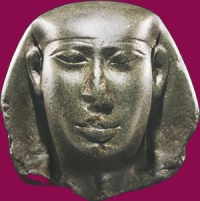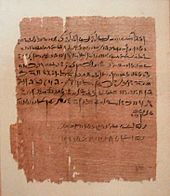Amasis (Pharaoh)
| Name of Amasis | |||||||||||||||||
|---|---|---|---|---|---|---|---|---|---|---|---|---|---|---|---|---|---|
| Horus name |
S-mn-M3ˁt Who strengthens the mate |
||||||||||||||||
| Sideline |
S3-Nj.t-spd-t3.w (j) son of Neith , who makes both countries splendid |
||||||||||||||||
| Gold name |
Stp-nṯr.w chosen one of the gods |
||||||||||||||||
| Throne name |
Khnum -ib-Re ẖnm-jb-Rˁ provided with willpower, a Re |
||||||||||||||||
| Proper name |
Jˁḥ msj [w] The moon is born |
||||||||||||||||
|
Greek for Manetho |
Amosis | ||||||||||||||||
Amasis (also Ahmose II. ) Was an Egyptian pharaoh (king) who lived from 570 BC. BC to 526 BC Ruled. He was the fifth ruler of the 26th Dynasty (Late Period), the so-called Saïten Dynasty.
The rise to Pharaoh
Amasis was originally an officer in the Egyptian army and came from a humble background. His place of birth was Siuph near Saïs . As a general, he participated in the Nubian campaign of Pharaoh Psammetich II in 592 BC. Part.
In 570 BC Amasis received the order from Pharaoh Apries to put down a revolt of local soldiers ( Machimoi ) in the Nile Delta. This revolt was followed by a heavy defeat by Egyptian troops in 571 BC. In the fight against the Greek city-state of Cyrene . The few survivors of the debacle suspected Apries of having ordered this campaign as the incumbent pharaoh to strengthen the power of the Greek mercenaries in the country. Amasis took advantage of the opportunity to become pharaoh himself and joined the rebels , who were mainly composed of local soldiers.
The uprising under his leadership led to the overthrow of Pharaoh Apries. The rebels declared Amasis king. Between the local soldiers under Amasis' leadership and the Greek mercenaries remaining at Apries, Momemphis took place in 569 BC. To battle. Amasis won this fight.
Amasis first had to rule in 568 BC. Against the Babylonian king Nebuchadnezzar II and against another attack of the overthrown pharaoh Apries (567 BC). He was able to fend off these challenges successfully. 570 BC Amasis incorporated Cyprus into the Egyptian domain.
politics
In contrast to its predecessor, Apries, Amasis did not try to conquer new areas in the east and west. Through his cautious policy, he was able to improve the relationship between the New Babylonian Empire and Egypt so much that no further armed conflict took place between these two states.
Under his rule, Egypt opened up primarily to Greek foreign countries. In doing so, he was doing exactly the opposite of what the rebels had actually aimed at against his predecessor Apries. According to Herodotus , Amasis was therefore not popular with his Egyptian subjects at the beginning of his reign and had to gain respect through his skillful politics and the resulting economic prosperity.
Amasis maintained friendly relations with Cyrene and other Greek city-states. These were particularly underpinned by his marriage to Ladike, a Greek woman from Cyrene. The Greek colony of Naukratis , founded around 630 BC. Was founded, was given the status of a free trade area during his reign . The entire trade between Greece and Egypt was carried out here, making the exchange of goods for the Egyptians controllable. Amasis also allowed the Greeks to build sanctuaries in their colony . When the Temple of Delphi burned down, he donated 1,000 talents of silver to rebuild it. These privileges were interpreted by his Egyptian subjects as an outspoken Greek friendliness.
Under Amasis, Egypt reached a high point of economic prosperity and prosperity. He furnished the temples of Lower Egypt with magnificent shrines and other monuments that have been preserved to this day. Construction activity for the time of Amasis can be traced back to the cities of Saïs , Athribis , Buto , Memphis , Mendes , Abydos , the oasis of Bahrija and the island of Philae .
His court is relatively well known. The "head of the gate guard" Ahmose-sa-Neith appears on numerous monuments, including his sarcophagus. It is still mentioned on monuments of the 30th Dynasty and apparently had a special meaning in its time. Wahibre was "Head of the Southern Foreign Countries" and "Head of the Doors of Foreign Countries", so he was the highest authority in securing the borders. The career of the doctor Udjahorresnet began under Amasis , who was then of particular importance among the Persians. Several "chiefs of the fleet" are known. Psamtek-Meryneit and Pasherientaihet / Padineith are the only documented viziers .
The Persian threat
The last years of his reign were marked by the struggle against the increasingly powerful Persian Empire . First was 542 BC. An alliance was made with the Lydian king Croesus and the Babylonian king Nabonidus . However, the alliances were no longer converted into actual aid. 541 BC BC Croesus was defeated and in 539 BC The New Babylonian Empire was conquered by the Persians without Egypt being able to support its allies.
After 538 BC Chr. Polycrates of Samos had taken the rule, he also included an alliance with Amasis. The background was the constant threat to Samos from the Cretan fleet. In connection with this alliance, a story by Herodotus is often used, in which Amasis, due to the continued happiness of Polycrates, feared too strong a challenge from the gods and therefore canceled the alliance. The reality was different: The Cretan fleet wore itself out in battles against Samos and was no longer a threat to Polycrates. After the death of Cyrus II , Cambyses II followed in 530 BC. As ruler over Persia. Polycrates also recognized the Persian danger and knew of Persia's interest in Egypt. He therefore terminated the alliance for strategic reasons Amasis. Polykrates hoped that this plan would generate a benevolent reaction from Persia. Cambyses later gratefully accepted the following open alliance proposal.
A text written in demotic script mentions, through a list of the soldiers involved, a campaign in the direction of Nubia in the 41st year of Amasi's government (529 BC).
Death and succession
526 BC Amasis died. His successor was his son Psammetich III. on.
Assessment in historiography
Amasis is by far the most colorful of the rulers of the 26th Dynasty. He loved happy carousing and rough jokes. He was considered by his contemporaries as a man of "extraordinary intelligence and measured and just in his character" (quote from Diodor I 95, 1). Despite these qualities and his political talent, however, he failed to secure Egypt against the threat from the Persians. He is the last (native) Egyptian Pharaoh who can still be described as 'great' (that is, powerful). Amasis' success as Egyptian ruler justified his coup against Apries in retrospect.
List of relics from the time of Amasis
| Fund / building | place | archaeologist |
|---|---|---|
| Construction of a new temple (unspecified) | Buto | Arnold |
| Construction of a new Isis temple | Behbeit el-Hagar | Arnold |
| Redesign of a temple of the goddess Neith | Saïs | Arnold |
| Extension of a temple | Mendes | Arnold |
| Construction of a new temple of the god Chentechtai | Attributes | Arnold |
| Construction of a new temple of the goddess Isis | Memphis | Arnold |
| Reconstruction of the temple of the gods Jentimeniu and Osiris | Abidos | Arnold |
| Extension of the temple of the goddess Satet | Elephantine | Emperor |
| Temple of the god Amun | Siwa oasis | Arnold |
| Inscription on a stone | Elephantine | Petrie |
| Stele of London | ? | Leahy |
| Blocks of stone, remains of buildings of unclear purpose |
Koptos Karnak Philae Istabl Antar Ain el-Muftella Baharya Oasis |
Arnold |
| Stone block | Memphis | Petrie Mackay Wainwright |
| Blue stone cone | Heliopolis | Saleh |
literature
Most of the information known about his life today comes from the works of Herodotus and can only be partially substantiated by archaeological evidence.
- Herodotus, trans. by Josef Felix: Histories . Artemis-Verlag, Zurich 2004, ISBN 3-7608-4111-2 .
- Further literature
- Hermann Bengtson : Greek History from the Beginnings to the Imperial Era, Handbooks of Classical Studies Vol. III. Munich 1977.
- Leo Depuydt : Saite and Persian Egypt, 664 BC-332 BC (Dyns. 26-31, Psammetichus I to Alexander's Conquest of Egypt). In: Erik Hornung, Rolf Krauss, David A. Warburton (eds.): Ancient Egyptian Chronology (= Handbook of Oriental studies. Section One. The Near and Middle East. Volume 83). Brill, Leiden / Boston 2006, ISBN 978-90-04-11385-5 , pp. 265-283 ( online ).
- Elmar Edel: Amasis and Nebuchadrezar II. (Göttinger Miszellen 29), Göttingen 1978, pp. 13-20
- Helmut Berve : The Tyranny of the Greeks Vol. I. Munich 1967.
- Alan H. Gardiner : History of Ancient Egypt. Weltbild-Buchverlag, Munich 1993, ISBN 3-89350-723-X .
- Friedrich Karl Kienitz : The political history of Egypt from the 7th to the 4th century before the turn of the times. Akademie-Verlag Berlin 1953, license no. 202 * 100/29/52
- Thomas Lenschau : Themistocles. In: Paulys Realencyclopadie der classischen Antiquity Science (RE). Volume XXI, 2, Stuttgart 1952, Col. 1726-1737.
- Eduard Meyer : History of antiquity - third volume: The outcome of ancient oriental history and the rise of the West up to the Persian Wars. Scientific Book Society, Darmstadt 1975, 5th edition.
- Richard Pietschmann : Amasis 2 . In: Paulys Realencyclopadie der classischen Antiquity Science (RE). Volume I, 2, Stuttgart 1894, Col. 1745-1747.
- Diana Alexandra Pressl: Officials and soldiers: the administration in the 26th dynasty in Egypt (664-525 BC). Publishing house Peter Lang in Frankfurt am Main 1998, ISBN 3-631-32586-X .
- Thomas Schneider : Lexicon of the Pharaohs. Albatros, Düsseldorf 2002, ISBN 3-491-96053-3 , pp. 51-52.
Web links
- Karl Jansen-Winkeln: Amasis. In: Michaela Bauks, Klaus Koenen, Stefan Alkier (eds.): The scientific biblical lexicon on the Internet (WiBiLex), Stuttgart 2006 ff., Accessed on May 26, 2012.
| predecessor | Office | successor |
|---|---|---|
| Apries |
Pharaoh of Egypt 26th Dynasty |
Psammetich III. |
| personal data | |
|---|---|
| SURNAME | Amasis |
| ALTERNATIVE NAMES | Ahmose II .; Ahmose (proper name); Khnum-ib-Re (throne name); Se-men-maat (Horus name); Sa-Neith-seped-taui (Nebtiname); Setep-netjeru (gold name) |
| BRIEF DESCRIPTION | Egyptian pharaoh |
| DATE OF BIRTH | 7th century BC Chr. |
| DATE OF DEATH | 526 BC Chr. |




